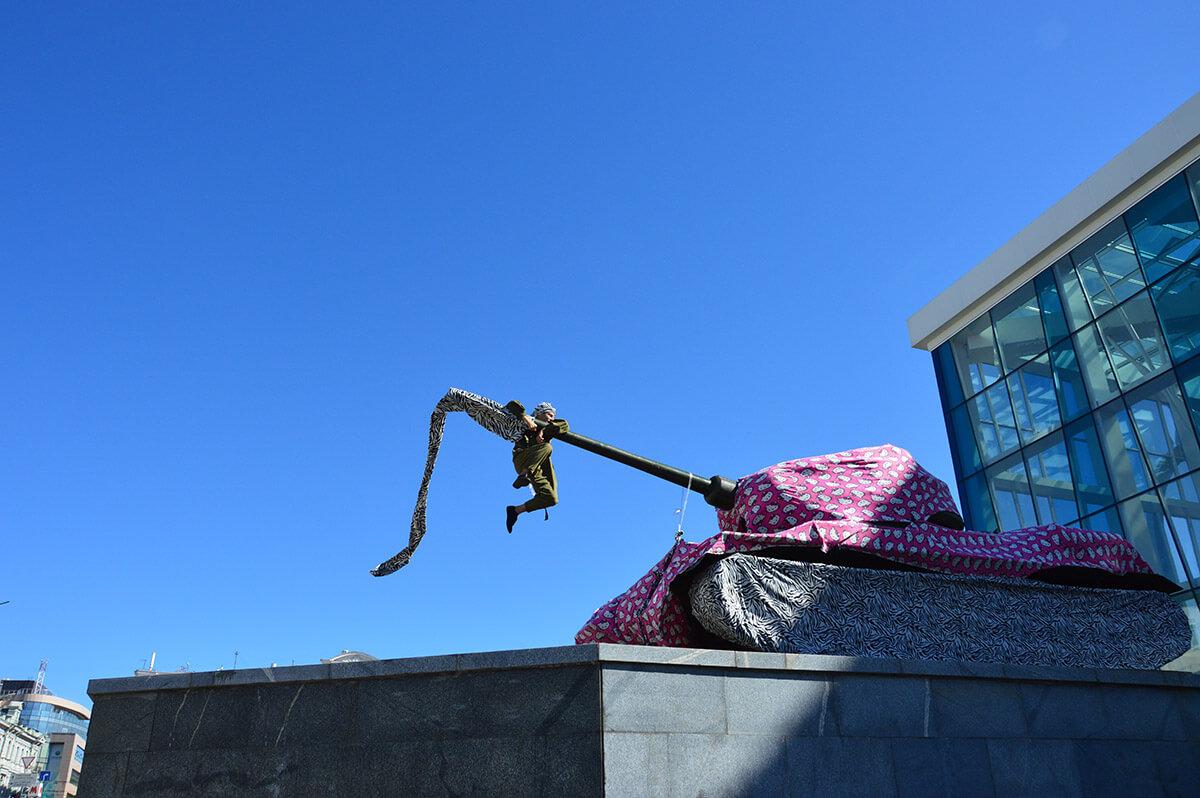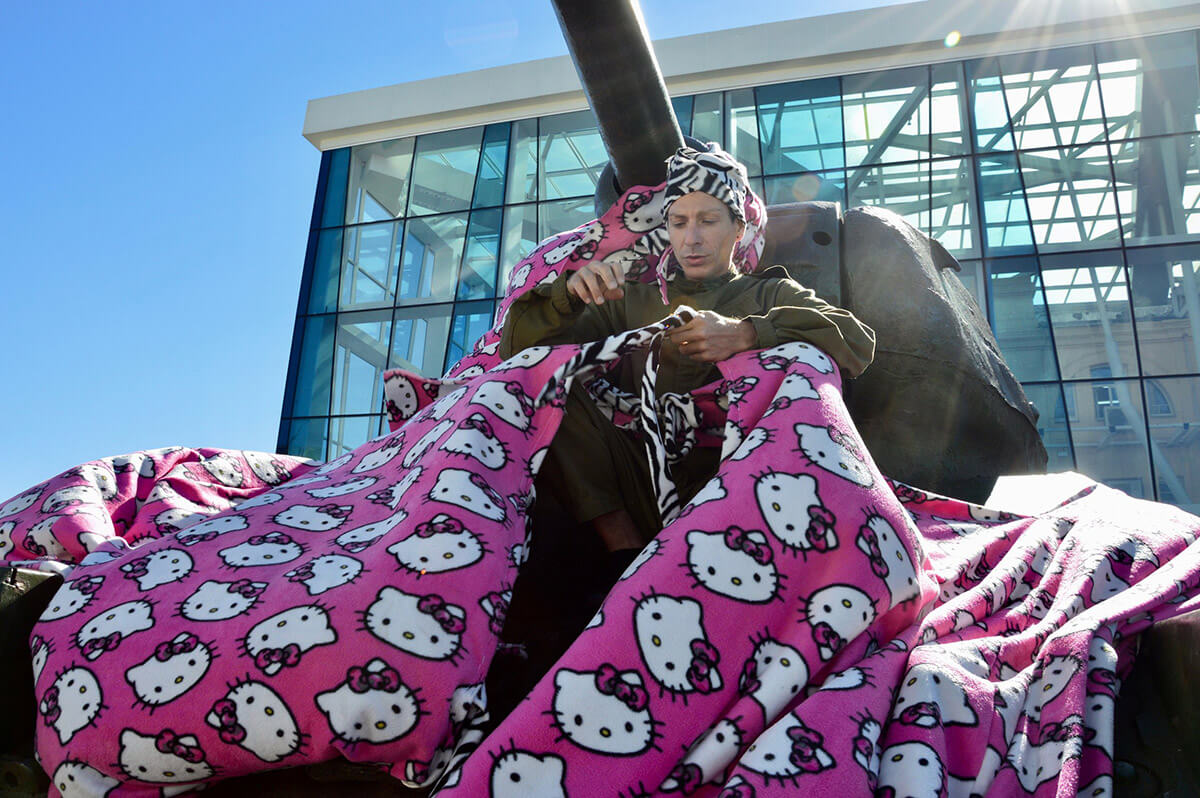Pajama Party with a Tank: A Cathartic Confluence of War and Peace in Matlakas’s Performance in Ukraine

In a juxtaposition of the harsh metal contours of a war machine and the comforting, familiar pattern of Hello Kitty pajamas, the performance art piece “Pyjamas Party in Ukraine” by Matlakas presents a profound commentary on war, peace, and the transformative power of art. Staged amidst the backdrop of the Municipal Gallery in Kharkiv, Ukraine, during a 40-day residency sponsored by the British Council in collaboration with the Liverpool Biennale, this artistic act sought to construct a dialogue between seemingly incongruent symbols: the cruelty of war and the innocence of sleepwear.
Dressing the War Machine in Pajamas
Central to this visual spectacle was an original T-34 tank from the Second World War, a symbol of destruction and power, which was chosen to be enveloped in oversized pyjamas made from a vibrant piece of Hello Kitty fabric. This act, draped in metaphorical resonance, witnessed a man – attired in a onesie that echoed the utilitarian austerity of a war khaki uniform, and a turban imbued with a kaleidoscopic array of colors – traverse over the tank, hanging on its barrel, and diligently working for two hours, crafting pyjamas for the massive war apparatus.
This endeavor involved a clandestine twist: the creation of a fake permission document, challenging norms, and injecting a playful yet subtly rebellious undertone to the event. The act of wrapping the tank in pyjamas evolved into a slow, contemplative performance, transforming the weapon of war into an object, unexpectedly delicate, almost childlike.

Cathartic Transformation: War Asleep, Peace Awakens
Matlakas’s performance sought to create a cathartic shift in perception, whereby the symbolic “putting to bed” of war, visualized by cloaking the tank in pajamas, serves as a compelling plea to allow peace to awake and proliferate. The playful and soft imagery of the pajamas colliding with the harsh, rigid reality of the tank brings to light the stark contrast between conflict and serenity, aggression, and calm.
The jarring visual also generates a psychological space where viewers can confront the brutality of war through a softened lens, allowing them to process, consider, and hopefully, relinquish the agony and trauma often associated with such destructive machinery. In this, the performance does not merely act as a symbolic representation but invites audiences to engage with their own internal landscapes of conflict and peace.
The performance poetically intersects with the collective longing for a cessation to the horrors unleashed by the Russo-Ukrainian War. It stands as a visual catharsis, a momentary pause where a tool of devastation is rendered impotent, even if symbolically, under the tender guise of slumber, signifying a dormant state for conflict and an awakening of peace. Here, the artist transcends conventional forms of political commentary, embedding a narrative that concurrently acknowledges the devastation while sowing seeds of hope and resistance through art.
In a backdrop fraught with unrelenting violence and a future teetering precariously on the brink, the gesture of coaxing the war to sleep, to shroud it in the innocence of child-like slumber, emanates as a soft yet undeterred rebellion against the violent tapestry of conflict that has enveloped Ukraine for years. “Pyjamas Party in Ukraine” extrapolates upon the concept of art as an instrument for cathartic transformation within society. This performance explores the manifold layers of human consciousness, navigating through a myriad of social and ethical issues that our global society grapples with, primarily the perpetual tension between conflict and desire for peace.
Art, in this context, becomes a transformative medium, wherein symbols of violence and tranquility are intertwined to create a paradox that stirs reflection and, possibly, a re-evaluation of the socio-political landscape. The serenity desired in the form of peace is not merely projected but is actively created through the re-contextualization of war symbols.
Matlakas’s performance draws on the immediate political and historical contexts of Ukraine, a nation that has experienced the brunt of conflict, yet extends beyond, reaching into the collective consciousness of a global audience. It implores individuals and communities alike to reconsider their associations with symbols of war and peace.
The Hello Kitty pajamas enveloping the tank emerge not merely as a whimsical, eccentric artistic choice but as a profound statement that delicately teases out the absurdity of conflict and underscores an urgent, poignant plea for peace. In this silent rebellion against the machinery of war, Matlakas invites viewers to a pyjama party where the nightmares of conflict can be transcended, even if momentarily, through the collective dreaming of peace.
The Future Threads: Woven through Collective Consciousness
As the world remains embroiled in various conflicts, “Pyjamas Party in Ukraine” poses an essential reflection: can we dare to dress our fears, traumas, and conflicts in a fabric that alters our interaction and perception of them? While the tanks may not literally be put to bed, the conscious awakening resulting from such an artistic exploration nudges societies towards contemplation, dialogue, and perhaps, towards crafting a future where peace is not asleep, but vividly awake and thriving within the collective consciousness.
In the silent streets of Kharkiv, where the tank stood adorned in its incongruous attire, a whisper through the fabric of society was initiated, murmuring the eternal hope that, someday, the machinery of war may truly be put to rest, allowing humanity to awaken into a dawn of unbroken peace.
You can find out more about the artist on his Website